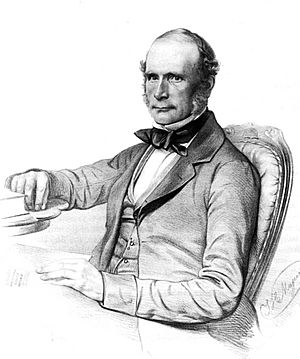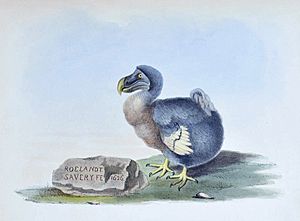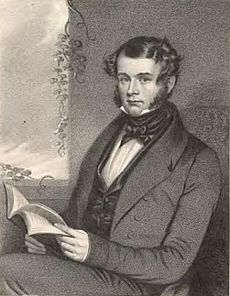Hugh Edwin Strickland facts for kids
Quick facts for kids
Hugh Edwin Strickland
|
|
|---|---|
 |
|
| Born | 2 March 1811 Reighton, East Riding of Yorkshire, England
|
| Died | 14 September 1853 (aged 42) |
| Citizenship | Britain |
| Scientific career | |
| Fields | Geology Ornithology Natural history Systematics |
Hugh Edwin Strickland (born March 2, 1811 – died September 14, 1853) was an English scientist. He was a geologist (someone who studies Earth's rocks and history). He was also an ornithologist (a bird expert) and a naturalist (someone who studies nature). He helped create important rules for naming animals. These rules were called the Strickland Code. They were very important for how scientists name new species today.
Contents
Early Life and Education
Hugh Edwin Strickland was born in Reighton, a place in East Riding of Yorkshire, England. He was the second son of Henry Eustatius Strickland. His mother, Mary, was the daughter of Edmund Cartwright. Edmund Cartwright invented the power loom, a machine for weaving cloth.
From a young age, Hugh loved natural history. This interest stayed with him his whole life. He had private teachers at home. In 1829, he went to Oriel College, Oxford University. There, he learned about anatomy from John Kidd. He also studied geology with William Buckland. Hugh became very interested in both zoology (the study of animals) and geology. He earned his first degree in 1831 and a master's degree in 1832.
In 1845, Hugh married Catherine Dorcas Maule Jardine. She was the daughter of Sir William Jardine, another famous naturalist. Catherine drew many pictures for Hugh's books. She often used her initials, CDMS, on her artwork.
Travels and Discoveries
After finishing university, Hugh returned home. He started studying the geology of the Vale of Evesham. He wrote papers about his findings for the Geological Society of London. He also spent a lot of time studying birds.
In 1835, Hugh met Roderick Murchison, a well-known geologist. Murchison introduced him to William Hamilton. Hugh then joined Hamilton on a trip through Asia Minor (modern-day Turkey). They also visited the Thracian Bosporus and the island of Zante (now Zakynthos). Hamilton later wrote a book about their travels.
When Hugh returned in 1836, he shared his discoveries. He presented several papers to the Geological Society. These papers were about the geology of the places he had visited. He also described "drift deposits" in the counties of Worcester and Warwick. He noted that hippopotamus bones were found in these deposits. With Murchison, he wrote an important paper about the "New Red Sandstone System." This paper focused on areas in Gloucestershire, Worcestershire, and Warwickshire.
Important Scientific Work
Hugh also wrote many papers about birds. These were for the Zoological Society of London and the British Association for the Advancement of Science. In 1842, he wrote a report for the British Association. This report was about the rules for naming animals. These rules were the first official set of guidelines for zoological nomenclature. They helped make sure that animal names were stable and consistent. This was a very important step for biology.
Hugh was one of the people who started the Ray Society in 1844. This society published books on natural history. These were books that other scientific groups or publishers could not take on. For the Ray Society, Hugh helped edit a large book called Bibliographia Zoologiae et Geologiae. This book was a list of all known works on zoology and geology.

In 1845, he helped edit a new edition of Murchison's book on the geology near Cheltenham. In 1846, Hugh moved to Oxford. Two years later, he wrote a book with Alexander Gordon Melville. This book was called The Dodo and its kindred (1848). It was about the Dodo and other extinct birds.
Later Life and Legacy
In 1850, Hugh became a geology teacher at Oxford University. He filled in for William Buckland, who was ill. In 1852, he was chosen to be a Fellow of the Royal Society. This is a very high honor for scientists.
In 1853, Hugh attended a meeting in Hull. After the meeting, he went to look at rock layers near Retford. He was examining the ground near a railway track. Sadly, he was hit by a train and died. He was buried at Deerhurst church near Tewkesbury. A special window was placed there to remember him.
Hugh's book, Ornithological Synonyms, was published after he died in 1855. His collection of 6,000 birds was given to Cambridge in 1867. During his travels in 1835, he discovered two new bird species. These were the olive-tree warbler on the island of Zante and the cinereous bunting near İzmir in Turkey.
Hugh Edwin Strickland's name lives on. A bird found in Borneo, Copsychus stricklandii, was named after him. Also, a type of ancient sea creature, a brachiopod, was named Stricklandia in his honor.


